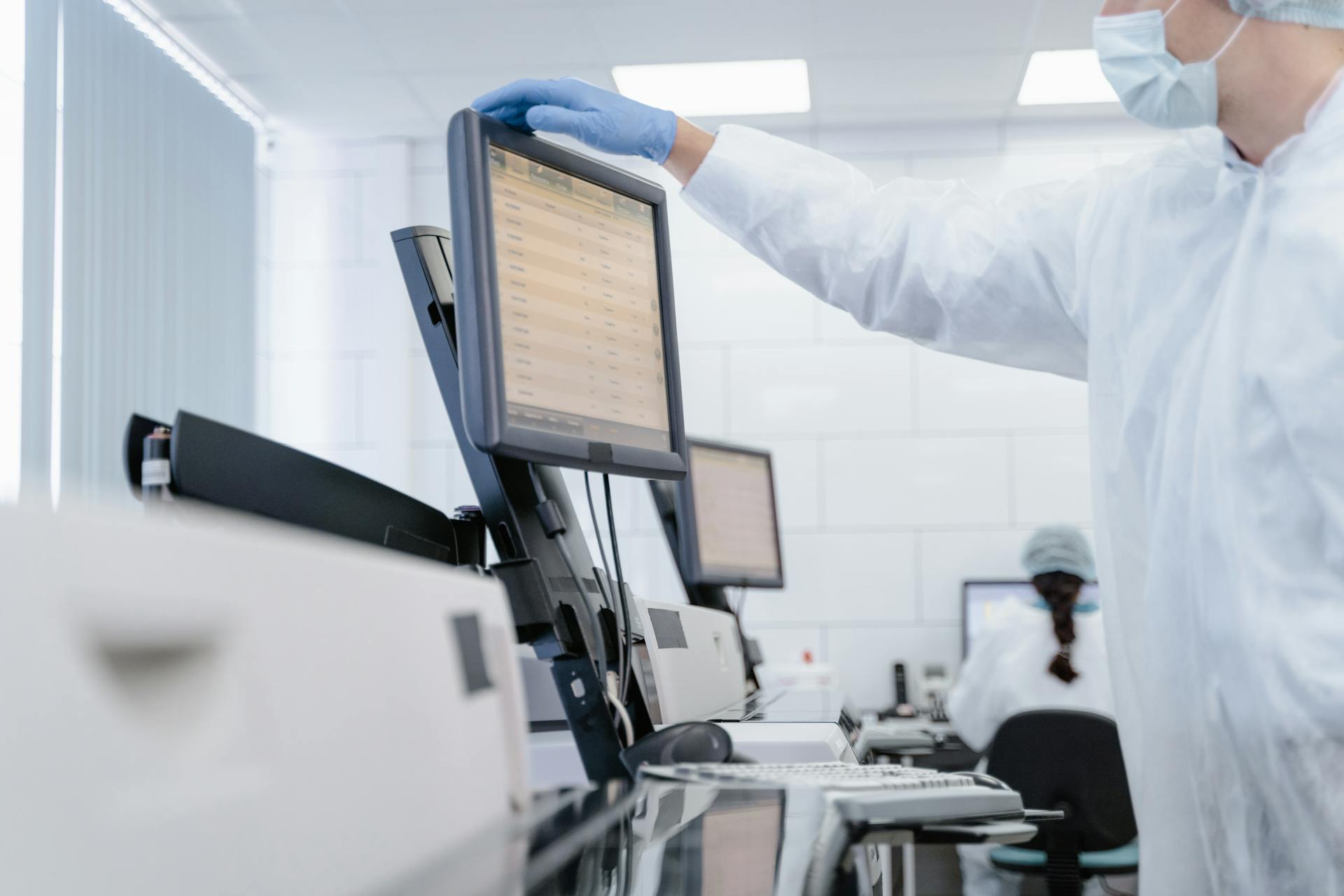
Model drift and data drift are two common issues that can affect the performance of machine learning models. Model drift occurs when the model's predictions or outputs change over time, often due to changes in the underlying data distribution.
Data drift, on the other hand, happens when the underlying data distribution itself changes. This can be due to various reasons such as changes in user behavior, seasonal variations, or external factors.
One key difference between the two is that model drift can be caused by changes in the model's parameters or architecture, whereas data drift is primarily driven by changes in the data itself.
What Is Model Drift?
Model drift occurs when the underlying distribution of the data being used to train a machine learning model changes over time.
This can be due to various factors, such as changes in the population or behavior of the users, updates to the data collection process, or shifts in the environment.
Model drift can cause a previously well-performing model to degrade in performance, leading to inaccurate predictions and poor decision-making.
For example, if a model is trained on data from a specific region and is then deployed to a different region, it may not perform well due to differences in the underlying data distribution.
Model drift can be subtle and may not be immediately apparent, making it challenging to detect and address.
Causes of Model Drift
Model drift occurs when changes in the underlying patterns or relationships in the data cause the model to become less accurate over time. This can happen when new features are added or removed from the data, or when the data distribution changes.
One common cause of model drift is changes in user behavior, such as shifts in how users interact with a website or app. For example, if a website's layout is redesigned, users may start using it in different ways, causing the model to become less accurate.
Changes in external factors, such as seasonality or holidays, can also cause model drift. For instance, if a model is trained on sales data from a specific time of year, it may not perform well when faced with data from a different time of year.
Types of Model Drift
Model drift can be a real challenge, and understanding its types is crucial to addressing it effectively.
There are four main types of model drift to monitor in your production model: prediction drift, concept drift, data drift, and upstream drift.
Prediction drift represents a change in a model's predictions over time, reflecting a change in predictions from new values compared to pre-production predictions.
Concept drift is about a change in actuals, which can be a significant issue if your model is relying on outdated information.
Data drift is simply a change in distributions, which can happen over time due to various factors.
Upstream drift, on the other hand, is a change in the data pipeline, which can also impact your model's performance.
You might like: Types of Data Drift
Change in Correlations
Change in Correlations is another key indicator of Model Drift. This method involves monitoring changes in how model features and predictions relate to each other, as well as pairwise feature correlations.
You can use correlation coefficients like Pearson's or Spearman's to evaluate the strength of these correlations and visualize them on a heatmap. This helps identify significant changes in the relationships between features.
This method works best with smaller datasets, such as those in a healthcare setting, where features are interpretable and there are known strong correlations. However, it can be too noisy in other scenarios, making it impractical to track individual feature correlations.
To make this method more manageable, you can run occasional checks to surface the most significant shifts in correlations, or focus on the correlation between a few strong features.
You might enjoy: Bootstrap Method Machine Learning
Gradual vs Sudden Change
Gradual concept drift is the most frequent type of drift, happening when underlying data patterns change over time. This is what the word "drift" itself means – a slow change or movement.
In cases like fraud detection, you have to account for the bad actors adapting and coming up with new fraud attacks over time. This gradual drift is almost an in-built property of a machine learning model.
The world will change sooner or later, and you can often observe a smooth decay in the core model quality metric over time. The exact speed of this decay varies and heavily depends on the modeled process and rate of change in the environment.
For example, you can update your models daily, weekly or monthly to prepare for the gradual concept drift. This allows you to evaluate the speed of the model decay and environmental changes in advance.
Sudden concept drift is the opposite, an abrupt and unexpected change in the model environment. This can catch models off guard, like when a new competitor enters the market with a heavily discounted product, completely changing customer behavior.
Many drastic changes, such as a change in the interest rate, might make your previous model outdated, making it hard to miss the need for retraining. COVID-19 was a perfect example of a drastic change that affected all ML models across industries.
A different take: Concept Drift
Detection and Monitoring
Data drift detection refers to the "global" data distributions in the whole dataset, whereas outlier detection identifies individual objects in the data that look different from others.
To detect data drift, you can compare the distributions of the input features and model output, which helps with early monitoring and debugging ML model decay.
Monitoring for prediction drift provides insights into model quality and overall model performance, and it's essential to catch prediction drift before your model degrades to the point of negatively impacting your customers' experience or intended business outcomes.
Concept drift refers to a drift in actuals, or a shift in the statistical properties of the target or dependent variable(s), which signifies a fundamental change in the relationship between current actuals and actuals from a previous time period.
To detect concept drift, you can set up ML model monitoring, which helps track how well your machine learning model is doing over time. You can track various metrics, including model performance, input data drift, and prediction drift.
A unique perspective: Concept Drift vs Data Drift
Here are some metrics you can track to detect concept drift:
- Model performance metrics, such as regression performance or classification performance
- Input data drift metrics, such as changes in data patterns or distribution plots
- Prediction drift metrics, such as changes in model output or prediction accuracy
Evidently is an open-source Python library that helps implement testing and monitoring for production machine learning models, providing 100+ pre-built checks and metrics to evaluate concept drift.
Addressing Model Drift
Addressing Model Drift requires a proactive approach to maintain model accuracy over time. Continuous monitoring of statistical properties of raw data and derived features is essential to detect changes that may lead to model drift.
Regular retraining of models is a fundamental strategy to counter model drift. By updating the model with new data and adapting to changing statistical properties, organizations can ensure that their models remain accurate. The frequency of retraining depends on the specific use case and the rate of data changes.
Human feedback is a valuable resource in addressing model drift. Employing human reviewers to evaluate model predictions and provide feedback can help identify and rectify discrepancies. This feedback loop can be integrated into the retraining process to continually improve model performance.
Broaden your view: What Is Human in the Loop
In some scenarios, model retraining under concept drift may not be possible. In these cases, business rules and policies can be modified to adjust model sensitivity to changes in the data distribution. For example, decision thresholds for classification models can be changed to reduce the number of false positives.
If model retraining is not possible, alternative decision-making strategies can be employed. Human-in-the-loop decision-making, heuristics, or other model types can be used to make decisions. For instance, first-principle physical models can be used in manufacturing process control, or rule-based systems can be used for prioritizing leads.
Here are some strategies to address model drift:
- Monitor statistical properties of raw data and derived features
- Regularly retrain models with new data
- Use human feedback to improve model performance
- Modify business rules and policies to adjust model sensitivity
- Employ alternative decision-making strategies
- Consider using heuristics or other model types
Training-Serving Skew
Training-Serving Skew is a situation where the model encounters a mismatch between the data it was trained on and the data it sees in production. This mismatch can occur due to various discrepancies, including issues related to data preprocessing, feature engineering, and more.
The model won't perform as well if it lacks important attributes it was trained to consider. For example, if the features available in training are not possible to compute in production or come with a delay.
You might face training-serving skew if you train the model on a synthetic or external dataset that doesn't fully match the model application environment. This can happen when the data used for training doesn't accurately reflect the real-world conditions the model will encounter.
Training-serving skew refers to the mismatch visible shortly after the start of the model production use. It's not just about gradual changes in the environment, but also about the immediate post-deployment window.
Strategies to Address Model Drift
Model drift can be a real challenge, but there are strategies to address it. Continuous monitoring of statistical properties is essential to detect changes that may lead to model drift.
Regular retraining is a fundamental strategy to counter model drift. By updating the model with new data and adapting to changing statistical properties, organizations can ensure that their models remain accurate.
Representative training data is vital to prevent model drift. Biased or outdated training data can exacerbate model drift, so it's essential to regularly refresh the training dataset and consider data balance and diversity.
Human feedback is a valuable resource in addressing model drift. Employing human reviewers to evaluate model predictions and provide feedback can help identify and rectify discrepancies.
Here are some strategies to address model drift:
- Monitor the statistical properties of both raw data and derived features
- Regularly retrain models with new data
- Ensure representative training data
- Use human feedback to evaluate model predictions and provide feedback
- Consider alternative decision-making scenarios, such as business rules and policies, human-in-the-loop, or alternative models
- Pause or stop the model if it's not performing well
- Do nothing if the model is not critical
In some cases, model retraining may not be possible. In these scenarios, you can consider other interventions, such as modifying decision thresholds, applying correctional rules, or switching to alternative models.
Data Drift vs Model Drift
Data drift and model drift are two related but distinct phenomena in machine learning. Data drift occurs when the statistical properties of the data change over time, which can be triggered by various factors.
Model drift, on the other hand, is the result of data drift, leading to reduced accuracy and degraded model performance. This shift in the model's performance can be caused by environmental changes, alterations in data collection methods, shifts in user behavior, or even transformations applied to data features.
Model drift can have unexpected outcomes, making it essential to monitor and adjust models regularly to maintain their accuracy.
Understanding Data Drift
Data drift occurs when the statistical properties of data change over time, causing a shift in the distribution of the data. This can happen due to various factors.
Environmental changes can trigger data drift, such as changes in temperature, humidity, or other external conditions. These changes can affect the data collected from sensors or other sources.
Data collection methods can also lead to data drift, for example, if the sampling rate or sampling interval changes. This can result in a different distribution of the data.
User behavior can shift over time, causing data drift, such as changes in how users interact with a system or application. This can affect the data collected from user interactions.
Transformations applied to data features can also lead to data drift, such as changes in data normalization or feature scaling. These changes can alter the distribution of the data.
Data drift can lead to reduced accuracy and degraded model performance, which can have significant consequences in various applications.
Suggestion: Distributional Shift
Comparison with Model Drift
Data drift and model drift are two distinct concepts in machine learning, and understanding their differences is crucial for maintaining accurate models.
Data drift occurs when the underlying distribution of the data changes over time, which can be due to various factors such as changes in user behavior, seasonality, or external events like natural disasters.
Model drift, on the other hand, happens when the model itself changes, often due to updates or changes in the data it's trained on, which can lead to a decline in its performance.
One key difference between the two is that data drift is often more predictable and can be detected with techniques like statistical analysis, while model drift can be more challenging to identify.
Data drift can be caused by factors like changes in user behavior, which can be seen in the article section where it's mentioned that changes in user behavior can lead to data drift.
Model drift, however, can be caused by updates to the model itself, such as changes to the algorithm or hyperparameters, which can be seen in the article section where it's mentioned that changes to the model can lead to model drift.
Expand your knowledge: Lead Data Enrichment
Best Practices
To mitigate model drift, it's essential to regularly retrain your model on fresh data. This can be done by scheduling regular retraining sessions, ideally every 3-6 months, depending on the rate of data drift.
Monitoring your model's performance on a continuous basis can help you detect changes in its behavior. This can be achieved through automated monitoring tools that track metrics such as accuracy, precision, and recall.
By implementing these best practices, you can stay on top of model drift and ensure your model continues to perform optimally.
Quality Metrics
Quality metrics are essential for detecting concept drift and model quality drops. Data quality issues can lead to observed data drift, but they are not the same thing.
To track model quality, you can monitor metrics like accuracy, precision, recall, or F1-score for classification problems. A significant drop in these metrics over time can indicate the presence of concept drift.
In some cases, you can calculate these metrics during production use, such as in spam detection scenarios where you gather user feedback. However, this isn't always possible, and proxy metrics and heuristics can serve as early warning signs of concept drift.
Proxy metrics and heuristics can tell you about changes in the environment or model behavior that might precede a drop in model quality.
Check this out: Confusion Matrix Metrics
Feedback and Diminishing Returns
Feedback drift can occur in models that have a feedback loop, such as causal models that simulate the effects of changing parameters on the end result.
This type of drift can be particularly problematic in models that involve manipulating behavior, such as churn models, fraud models, and recommendation engines.
In these cases, the results of the predictions can contaminate new features coming in, skewing the effects of those features.
Causal models are more heavily affected by feedback drift than traditional correlation-based machine learning models.
The variances of allowable parameters to adjust can shrink over time, making it difficult for the model to learn from new data.
This can lead to a situation known as the law of diminishing returns, where the model's performance degrades over time despite retraining.
To detect this issue, it's essential to record and measure the model's prediction quality over time, using tools like MLflow Tracking to track key metrics.
By monitoring the model's performance, you can identify when it's no longer improving and take corrective action to prevent diminishing returns.
Frequently Asked Questions
What are the different types of drift?
There are four main types of drift: prediction drift, concept drift, data drift, and upstream drift, each referring to changes in the data that can impact model performance. Understanding these types is crucial for maintaining accurate and reliable machine learning models.
Sources
- https://innodata.com/how-to-manage-model-drift-in-generative-ai/
- https://www.evidentlyai.com/ml-in-production/data-drift
- https://arize.com/model-drift/
- https://medium.com/@anicomanesh/model-drift-identifying-and-monitoring-for-model-drift-in-machine-learning-engineering-and-0f74b2aa2fb0
- https://www.evidentlyai.com/ml-in-production/concept-drift
Featured Images: pexels.com


